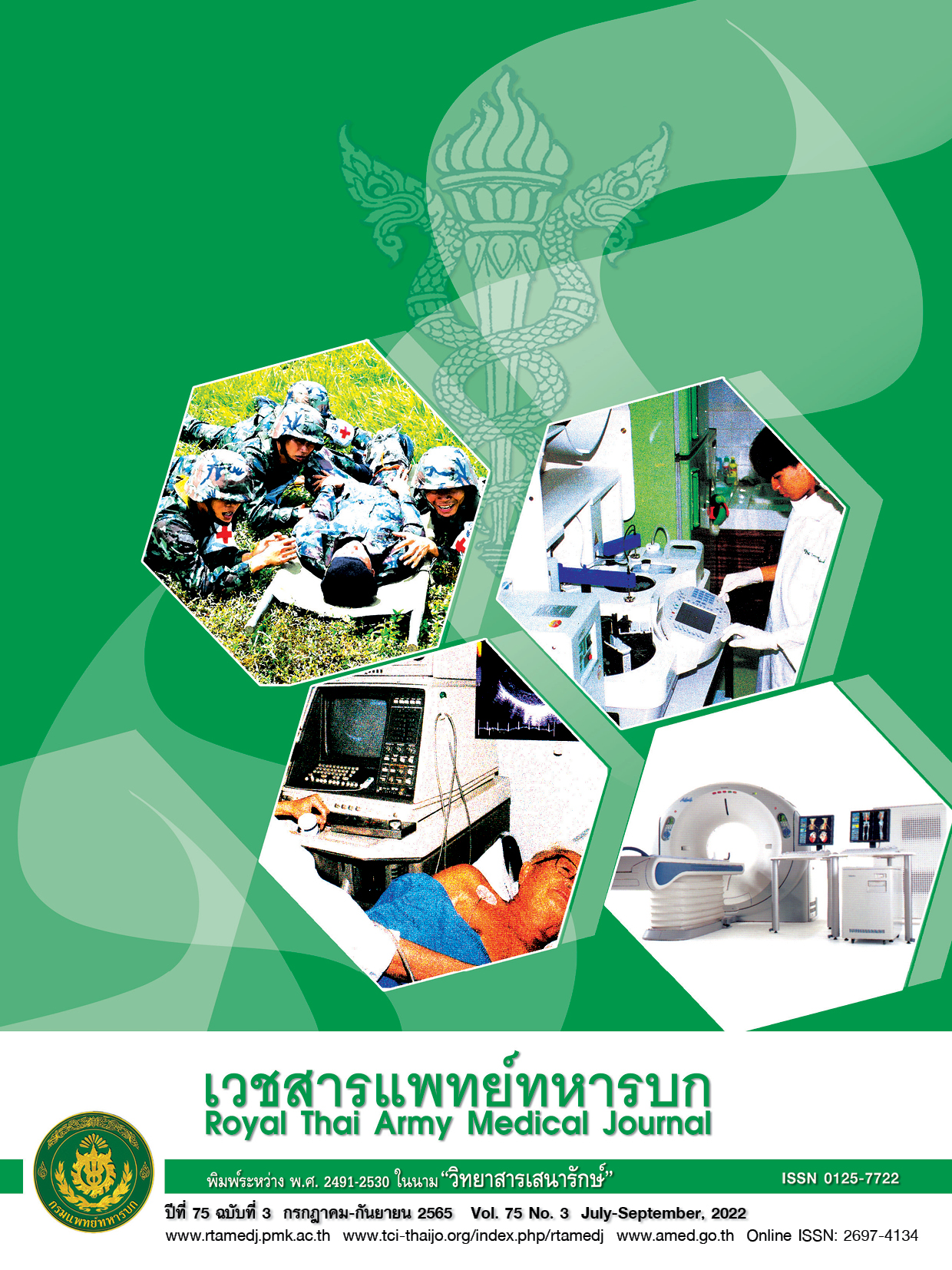Reconstruction of orbital floor fractures with 3D pre-bent titanium mesh: report of two cases
Main Article Content
Abstract
การแตกของกระดูกกระบอกตาเนื่องจากอุบัติเหตุมีหลายรูปแบบ ที่พบได้บ่อยรูปแบบหนึ่งคือการแตกของกระดูกพื้นกระบอกตา ซึ่งสามารถทำให้เกิดความผิดปกติของการทำหน้าที่ลูกตา และการผิดรูปของเค้าโครงใบหน้าได้หลากหลายระดับขึ้นกับกลไกและความรุนแรงของแรงที่มากระทำต่อลูกตาและตำแหน่งการแตกของกระดูกที่เป็นส่วนประกอบของกระดูกกระบอกตาที่เกี่ยวข้อง เช่น ใบหน้าไม่สมมาตร มองเห็นภาพซ้อนจากตำแหน่งลูกตาที่ไม่สมมาตรหรือภาวะกลอกลูกตาได้จำกัด และอาจสูญเสียการมองเห็นได้ในรายที่อาการรุนแรง
รายงานผู้ป่วยฉบับนี้กล่าวถึงผู้ป่วย 2 รายที่ได้รับอุบัติเหตุจากการใช้ยานพาหนะ มีปัญหาการมองเห็นภาพซ้อนเมื่อมองด้วยตาพร้อมกันสองข้าง สาเหตุจากกระดูกพื้นกระบอกตาแตกร่วมกับมีการจำกัดการเคลื่อนที่ของกล้ามเนื้ออินฟีเรียร์ เร็คตัส ให้การรักษาด้วยวิธีการยกกล้ามเนื้ออินฟีเรียร์ เร็คตัส และเนื้อเยื่อไขมันกลับเข้าสู่กระบอกตา ร่วมกับบูรณะกระดูกพื้นกระบอกตาที่แตกด้วยการเตรียมแผ่นตาข่ายไทเทเนียมล่วงหน้าโดยการใช้แบบจำลองสามมิติเพื่อลดเวลาที่ใช้ในการผ่าตัด เพิ่มความแม่นยำในการกำหนดตำแหน่งการบูรณะ และการคงปริมาตรกระบอกตาให้ใกล้เคียงภาวะปกติ
Article Details

This work is licensed under a Creative Commons Attribution-NonCommercial-NoDerivatives 4.0 International License.
References
2. Harish Saluja, Shivani sachdeva, Semmit shah, Anuj Dadhich, Parul Tandon, Vinayak More. Autogenous Grafts for Orbital Floor Reconstruction: A review. Int J Oral Craniofac Sci 2017;3(2):046-052. doi:10.17352/2455-4634.000031.
3. Chandrashekhar R. Bande, Surendra Daware, Pravin Lambade, Bhaskar Patle. Reconstruction of Orbital Floor Fractures with Autogenous Bone Graft Application from Anterior Wall of Maxillary Sinus: A Retrospective Study. J. Maxillofac. Oral Surg 2015;14(3):605–610. doi: 10.1007/s12663-014-0716-7.
4. Pasquale Piombino, Giorgio Iaconetta, Roberto Ciccarelli, Antonio Romeo, Alessia Spinzia, Luigi Califano. Repair of Orbital Floor Fractures: Our Experience and New Technical Findings. Craniomaxillofacial trauma & reconstruction 2010;3(4):217-221. doi:10.1055/s-0030-1268518.
5. Omar Kholaki, Daniel A. Hammer, Thomas Schlieve. Management of Orbital Fractures. Atlas Oral Maxillofacial Surg Clin N Am 2019;27(2):157-165. doi:10.1016/j.cxom.2019.05.007.
6. Tzu-Yen Chang, Jing-Wei Lee. An innovative technique in orbital floor reconstruction avoiding complications: Temporary use of the silicone guide. Formosan journal of surgery 2014;47(3):99-104. doi:10.1016/j.fjs.2014.02.002.
7. Lívia Bonjardim Lima, Renato Barjona Miranda de Miranda, Lair Mambrini Furtado, Flaviana Soares Rocha, Marcelo Caetano Parreira da Silva, Cláudia Jordão Silva. Reconstruction of orbital floor for treatment of a pure blowout fracture. Rev port estomatol med dent cir maxilofac 2015;56(2):122–126. doi:10.1016/j.rpemd.2015.04.010.
8. Gianni Frisardi, Giacomo Chessa. Integration of 3D anatomical data obtained by CT imaging and 3D optical scanning for computer aided implant surgery. BMC Medical Imaging 2011;11:5. doi: 10.1186/1471-2342-11-5.
9. Muhammad Syafiq Alauddin, Ahmad Syukran Baharuddin, Mohd Ifwat Mohd Ghazali. The Modern and Digital Transformation of Oral Health Care: A Mini Review. Healthcare 2021;9:118. doi:10.3390/healthcare9020118.
10. F.Schwendicke, W.Samek, J. Krois. Artificial Intelligence in Dentistry Chances and Challenges. Journal of Dental Research 2020;99(7):769-774. doi:10.1177/0022034520915714.
11. Maddalena Favaretto, David Shaw, Eva De Clercq, Tim Joda, Bernice Simone Elger. Big Data and Digitalization in Dentistry A Systematic Review of the Ethical Issues. Int. J. Environ. Res Public Health 2020;17:2495. doi:10.3390/ijerph17072495.
12. Gokce-Soganci Unsal, Ilser Turkyilmaz, Samantha Lakhia. Advantages and limitations of implant surgery with CAD/CAM surgical guides: A literature review. J Clin Exp Dent 2020;12(4):409-417. doi:10.4317/jced.55871.
13. Tim Joda, Michael M. Bornstein, Ronald E. Jung, Marco Ferrari, Tuomas Waltimo, Nicola U. Zitzmann. Recent Trends and Future Direction of Dental Research in the Digital Era. Int. J. Environ. Res. Public Health 2020;17:1987. doi:10.3390/ijerph17061987.
14. Alex M. Greenberg. Advanced dental implant placement techniques. J Istanbul Univ Fac Dent 2017;51(3 Suppl 1):76-89. doi:10.17096/jiufd.17594.
15. Andriy Fedorov, Reinhard Beichel, Jayashree Kalpathy-Cramer, Julien Finet, Jean-Christophe Fillion-Robin, Sonia Pujol, et al. 3D Slicer as an Image Computing Platform for the Quantitative Imaging Network. Magn Reson Imaging 2012;30(9):1323–1341. doi:10.1016/j.mri.2012.05.001.
16. I Susic, M Travar. The application of CAD / CAM technology in Dentistry. Innovative Ideas in Science 2016. doi:10.1088/1757-899X/200/1/012020.
17. Phillip W. Clapp, Emily E Sickbert-Bennett, James M. Samet, Jon Berntsen, Kirby L. Zeman, Deverick J. Anderson, et al. Evaluation of Cloth Masks and Modified Procedure Masks as Personal Protective Equipment for the Public During the COVID-19 Pandemic. JAMA Internal Medicine 2020. doi:10.1001/jamainternmed.2020.8168.
18. Hee Houng Lee, Nelson alcaraz, Anthony Reino, William Lawson. Anderson,. Reconstruction of Orbital Floor Fractures with maxillary Bone. Arch otolaryngol head neck surg 1998;124:56. doi:10.1001/archotol.124.1.56.

